Rick Steves's Blog, page 64
May 4, 2014
More Padova Photo Fun
Our filming of the Italian university town of Padova continues. One of our challenges here was to capture a slice of student life. As you’ll see from these photos, I think we succeeded.

While filming Padova’s Goliardia, we partied with this guy, Samuele Mattia Zanetti. And he came prepared for the opportunity to capitalize on my visit to find an American girlfriend. He seemed nice enough — with great hair — so I thought I’d help him out. If you’d like to meet a wild and crazy student from the north of Italy…there’s a good chance he’d like to meet you, too. Contact Samuele via his Facebook page (https://www.facebook.com/samuelematti...).

Filming in Padova, I wanted to catch the fun as a new graduate is roasted by his or her friends. While there were no graduations during our visit, my local guide friend managed to get the local goofball fraternity, the Goliardia, to play the role…and it worked great. Here we’re warming up with a drink in the student bar before they step out into the street and sing the university’s graduation anthem (which says, basically, “You’re a doctor, yes, you’re a doctor… but you’re still just an a-hole”).
[image error]
When filming in the big and famous cities, we go unnoticed by the local press. But in smaller towns, we sense the pride locals feel as we work to share their home with an American television audience. As we worked one day, the local reporter connected with us. The next morning we were in the paper. The headline: “Saints, Spritz, and Goliardia: Padova goes to the USA.”
May 3, 2014
Filming in Padova
It’s great to be joined by my film crew as we begin shooting the last episodes of our new television season (which airs this fall). We’re spending six days filming in Verona, Ravenna, and Padova (a.k.a. Padua). Here are a few shots that illustrate the fun we’re having as we kick things off in Padova. Just half an hour from Venice, Padova is a university town with 60,000 students and a wonderfully youthful vibe.

All over town, young people — apparently without a lot of private space in their apartments — hang out and kiss and cuddle in public spaces. These students seemed very comfortable literally under the medieval tomb of one of their city’s historic fathers.

All over Italy, people enjoy the early evening on the piazza with a spritz and friends. The local Campari drink is just an excuse for people to get together and enjoy some quality time as the sun sets, the floodlights come on, and —regardless, it seems, of the economy, the politicians, or your family troubles — life is good. We had an easy time making friends with the camera rolling and enjoying this slice of the Italian dolce vita.

Each episode of my series starts with a goofy “tease” where I welcome our viewers with some intimate activity — shearing a lamb, sizing up an octopus, or sweating in a sauna. For this show, I relieved a man of his artichoke-trimming work. Not quite trusting the rawhide glove and the razor-sharp knife, I gingerly topped the artichoke and said, “We’re back with more of the best of Europe…” Here you can see me behind the artichoke stand, reviewing the footage cameraman Karel Bauer shot.
May 2, 2014
RSVP for the Rick Steves Party
A very talented cartoonist (who clearly loves Europe) shared this vision of a Rick Steves party. I’d love to come, but Europe is my party this month — and it’s more fun than ever. Happy travels!
April 30, 2014
Festive Barcelona Is Packed
My visit to Barcelona coincided with a particularly crowded and lively time: Holy Week and Easter. I enjoyed getting a Catalan take on this holiday.

Barcelona — Where People Stroll Like Sardines
Barcelona is one of the darlings of European tourism lately. It’s the biggest cruise port in Europe and one of the biggest in the world (as a starting or ending point for a huge portion of all Mediterranean cruises). It’s trendy for its Gaudí “Modernisme”— Catalunya’s answer to Art Nouveau. Catalunya is feeling its nationalist spirit. It’s well served by discount airlines. And vacationers — both Spanish and foreign — fill its streets, especially during its many festivals. I happened to be here over Easter weekend, and the boulevards were often human traffic jams.
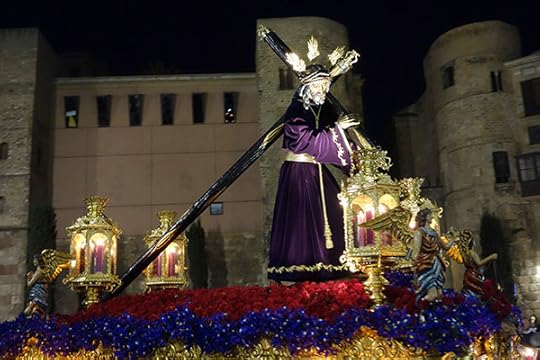
Barcelona Bunnies
Easter is a huge deal in Spain, especially in the south. Semana Santa (Holy Week) is one of the busiest and most festive times in Andalucía. But here in Catalunya, I found that Easter isn’t quite such a big deal. Catalans seem less religious, and the main duty of godfathers is to buy their godchildren overpriced decorative chocolate creations that fill shop windows. There was a Semana Santa-style parade, with teams of people trudging slowing down the street in tight formation, hidden under the huge religious floats they carried. But locals told me Catalans would never do this; these celebrants were from Andalucía, and travel each year to Barcelona to share their Easter traditions. While the churches may not have been overwhelmed with crowds, the Easter parade certainly jammed the streets.
April 28, 2014
Back in Barcelona, Where There’s Always Something New
I’ve left Portugal and have landed in Barcelona, where I’m sprucing up my new guidebook on this fun and fascinating city. A trip to Barcelona always comes with lots of learning for me — whether it’s the hottest dining and drinking trends (food tours and vermouth bars), the latest restored building in this city of bold and creative architects, or getting up to speed on the movement for the surrounding region of Catalunya to declare independence from Spain.
The theme in Europe over the last generation has been the rise of ethnic regions. As power gravitates to Brussels, the national capitals seem less concerned about their restless, would-be breakaway mini-states. For example, this year we’re hearing a lot about Scotland and Catalunya both seriously pursuing the possibility of declaring their independence from Britain and Spain, respectively. It’s always impressive for me to note that more people are speaking Europe’s small languages (Irish, Basque, Catalan, and so on) today than a generation ago. Talking to my friends in Barcelona about the practicality of having their children learn Catalan first at home and in school — leaving them with a native tongue that less than 10 million people speak in an aggressive and global world — none of them questioned the notion. Of course they’d speak Catalan…they are Catalans.
Here are pictures of three very different experiences I enjoyed on my latest Barcelona visit.
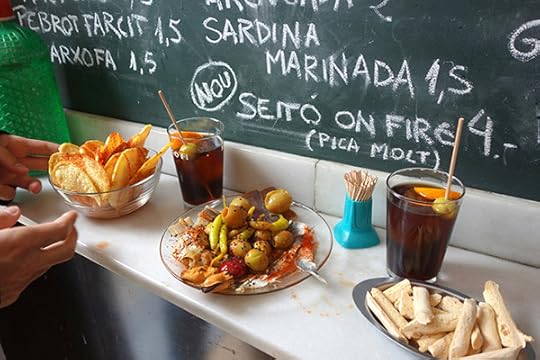
Last week I posted about a food tour I enjoyed in Porto, Portugal. Food tours— offering a mobile feast with several stops to sample a variety of local flavors for about the cost of a splurge dinner, all thoughtfully explained by a local guide — are a big trend across Europe. In Barcelona, as in many places, vermouth bars are all the rage these days. And as this photo shows, a refreshing glass of vermouth is complemented by a plate of local taste treats. Especially in Spain, this “tapas” style of eating and drinking makes for fun meals.
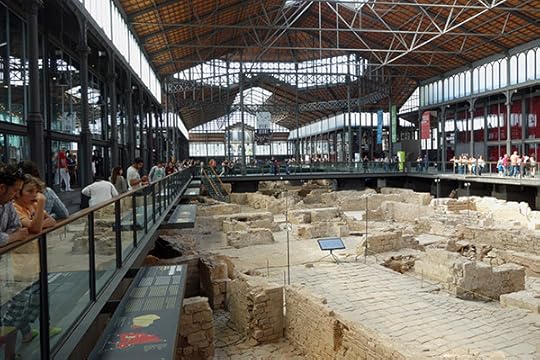
In Barcelona, the Ramblas pedestrian drag and the Gothic Quarter are understandably popular, but overrun with tourists. The new, happening quarter is El Born, just beyond the Gothic Quarter. A square called El Born (named for the tournaments once held there) faced a big 19th-century iron-and-steel market. In the 1970s, the vendors moved out, and the market was slated for demolition and redevelopment. But then they discovered the remains of a centuries-old neighborhood with a rich history: In 1714, the residents here lost an uprising against the Spanish, and were forced to demolish their homes and carry the very stones that gave them shelter to the neighboring hill to build a citadel — from where the Spanish crown would assert their control over the people of Catalunya. The leveled neighborhood then provided a cleared-out no-man’s-land outside the fort, which later became a place of execution. Later, in more peaceful times, the space was made into a market. And in the last few years, they unearthed the remains of those original Catalans. Today, the El Born Market is an inviting and inspirational cultural center that tells its story well.

In Francisco Franco’s time (until the mid-1970s), the people of Catalunya were not allowed to speak their language or fly their flag. So instead, they’d fly their soccer team’s flag. Then, once allowed, they flew their yellow-and-red-striped flag of Catalunya. And now you see many flags with a feisty addition: a blue triangle and a white star. This is inspired by the flag and spirit of the former Spanish colony of Cuba, which won its freedom from Spain in 1902. This Cuban/Catalan hybrid flag indicates that the people in this household support Catalunya’s independence from Spain.
April 26, 2014
A Picturesque Stroll Through Colorful Coimbra
I’m enjoying my visit to Coimbra. Just an hour from Lisbon, Coimbra is sort of the Oxford or Cambridge of Portugal —the home of its most venerable university. Here are a few colorful slices-of-life that I collected during my latest trip.

Coimbra Market — In the EU, but Still Funky
Every city in Europe seems to have a vibrant market where visitors can feel the wrinkled and fragrant pulse of the town. The European Union has asserted itself, raising hygiene standards and, in many cases, messing up a lot of the character. But here in Coimbra, the color and twinkle survives.

In Cod We Trust
Spain’s cuisine is more rustic than France’s. And Portuguese cuisine is more rustic than Spain’s. But if you like seafood, Portugal is a tasty treat. While fresh seafood is abundant, the Portuguese favor cod — salted cod, to be specific. Perhaps cod is in their collective DNA from the age when preserved-in-salt cod was the life-sustaining protein sailors filled the bilges of their ships with five centuries ago. Even in our age of refrigeration, and even when their own cod is fished out, the Portuguese continue to import dried and salted cod from Norway, stack it like wood, and — when it’s time to eat it — soak it and cook it. Frankly, it’s just the strangest thing: a nation’s primary staple imported from far-away Norway. Here in the Coimbra market, it seems to be sold by the cord.

Munchies with the Students at Coimbra’s University
When touring any city, it’s fun to drop in on the local university. Coimbra’s university is the city’s leading attraction (with an amazing library and an equally amazing chapel). While visiting universities anywhere, you can generally enjoy the cheapest meals in town — with the most interesting crowd of fellow diners in town (and, very likely, the locals most likely to speak English well) — by eating at the university cafeteria. Here in Coimbra, the cafeteria welcomes tourists. During busy times, all seats are taken, and you’re very likely to find yourself munching with law students or their professors.

Three Dailies — All Sports (Football)
I have to admit that with all the world’s challenges, I sometimes think sports are a convenient diversion designed to distract the potentially restless masses. Many attribute Europe’s ability to avoid wars in the last generations in part to how soccer (or “football,” as it’s known here) lets a society’s working class blow off steam. The newspaper industry may be in turmoil. But at newsstands throughout Portugal, you’ll notice there are three daily newspapers…and each is devoted to sports. And when they say “sports,” they mean football. Each newspaper features one of the big soccer teams, and many locals marvel at how creatively they struggle to fill each daily edition with “news.”
April 25, 2014
A Mobile Feast in Porto — With a Guide
Wherever you’re traveling in Europe, you can search online for a local food tour. I took one in Porto and had a great time…and a great meal. Here, at the end of a delicious tour, our guide, Andre (of Taste Porto Food Tours), recaps what we did.
If you can’t see the video below, watch it on YouTube.
Get a better browser!
April 24, 2014
My Kind of Gut Bomb
Every country has its hot dog-like gut bomb. And if you’re going to sample one of these local grease treats — and you should — it’s best to find a bar with character (and characters) that honors tradition and uses the freshest ingredients. Of course, that’s easiest to accomplish with the help of a local guide… or a guidebook written by a guy who uses these guides for several months every year as he updates and broadens his information.
This little stop, in Porto, is Cervejaria Gazela, next to the national theater and midway between breakfast and lunch. Warming a stool, chatting about the struggle of traditions in a rapidly modernizing world, and watching the bartenders assemble and grill these wonderful snacks — simple as they might be — was a highlight of my Porto morning (and cost only about €3 with my beer).
If you can’t see the video below, watch it on YouTube.
Get a better browser!
April 23, 2014
Who Wouldn’t Give?
All over Europe, main shopping streets are pedestrianized. Rather than dodging cars, holding your breath while buses go by, and yelling above the sound of rumbling trucks, you live in a world of pause-a-moment buskers, where jaywalking is impossible and the only thing you have to dodge are the tripwires of locals taking their dogs out for a stroll. Here’s just a moment on Porto’s Rua de Santa Catarina, as a local school choir is out raising money for a concert tour.
If you can’t see the video below, watch it on YouTube.
Get a better browser!
April 22, 2014
Europe’s “Second Cities” — Like Portugal’s Porto — Come in First
I am really into “second cities” these days. For generations, several European Industrial Age powerhouses (Antwerp, Hamburg, Glasgow, Bilbao, and so on) were what we would call “rust belt,” as their elegant “first city” counterparts enjoyed the luster of the Information Age. But over the last decade or so, the rust has become an accessory, bohemian can be chic, and places where people once joked “the shirts are sold with the sleeves already rolled up” are in vogue and bursting with creative energy. The obvious example in Portugal is Porto, three hours north of Lisbon by train. Here are some photos from my fascinating time in Portugal’s second city.
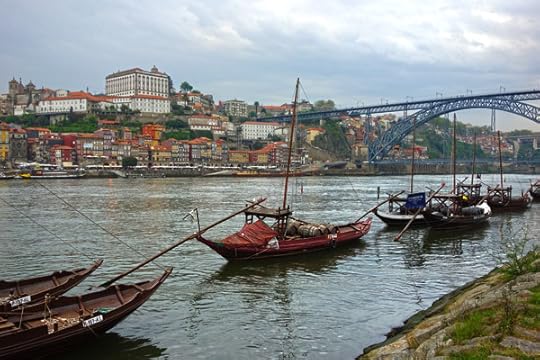
Ribeira View with a Port Buzz Lens
Porto ages happily on the Douro River, along with the most of the world’s port wine. The harborfront, called the Ribeira, faces Porto’s sister city, Vila Nova de Gaia, just across the river, where traditional boats that hauled the wine to the port lodges for aging and distribution decorate the scene. After visiting a couple of port lodges for a tour and tasting (as is the ritual for visitors to Vila Nova de Gaia), this view across the Douro of Porto’s Ribeira looks even better.
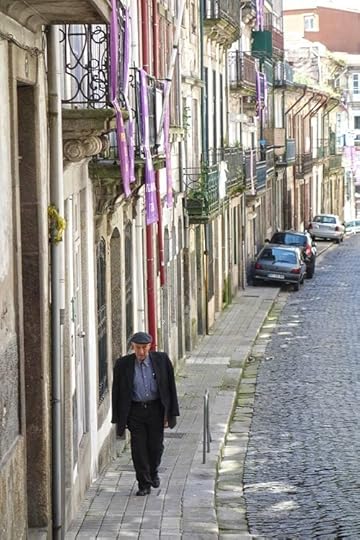
Porto Life Cobbled Together
When exploring the back streets of Porto, depth, light, well-worn people, and once-dazzling facades ferment into a nice glass of port for the eyes.

A Room with a View
My choice of hotels, restaurants, cafés, and bars in a city like Porto are places where the patina of the past comes with a little broken glass and rusty edges. Opening the window of my hotel room, I saw a view some would complain about. But this is why I come to Porto. Authenticity and heritage are the swizzle stick of my Porto experience.

Something Fishy About His Smile
Hardworking tour guides (like Ricardo Brochado) know how to make your stroll through their hometown memorable. Porto is a city with a steady sea breeze, a seagull soundtrack, and sardine smiles.

Sausage Man in Porto
Old Industrial Age markets (like Bolhão in Porto) are busy with activity under 19th-century glass-and-steel rooftops. You can be on a diet, but your camera will eat this up — sausage man and all — with gusto.

Porto Food Tour — For an Edible Education
All over Europe, food tours are trendy. They cost between €50 and €100, go at an early lunch or early dinner time, last around three hours, come with over a mile of walking, and include four to eight stops. The style varies: Some are standing and sharing a plate of little bites, while others feature more sit-down dining experiences. All will fill you up, and should be considered a meal as well as a tour, wrapped up in one (making the splurge easier to justify). Here, André of Taste of Porto Food and Wine Tours brings on dessert.
Rick Steves's Blog
- Rick Steves's profile
- 673 followers




